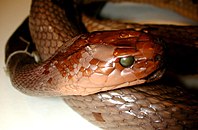Kevin Budden
Kevin Clifford Budden (September 27, 1930
Early life
After leaving school, Budden worked as a retail assistant in Randwick, New South Wales.[4] At that time he joined the Australian Reptile Club and began hunting snakes as a hobby. He built a snake pit and spent weekends in the bush collecting snakes.[5] In 1948, he caught 59 snakes and was bitten five times.[4]
Taipan capture and death
In March 1950, Budden travelled to
Legacy
At the time of Budden's death, there were various rumours about the taipan, but it was not until Budden had captured this specimen that serious consideration was given to the potency of its venom.[10] Two prior taipan specimens had been obtained in 1923, but those snakes were dead, and venom samples were contaminated.
Budden's captured snake was sent alive to the
In a 2014 article published in the Journal of Proteomics, University of Queensland venomologist Bryan Fry reported finding specimens of the venom harvested from the taipan that killed Budden. His study found that the venom had retained its toxicity after almost sixty years in dry storage.[3][14]
References
- ^ "Catalogue listing (Kevin Budden papers, 1948-1950)". Library of New South Wales. Retrieved 16 January 2014.
- ^ Mirtschin, P. (2006); "The pioneers of venom production for Australian antivenoms", in: Toxicon, Vol. 48, p. 899-918. Retrieved online, 17 June 2017.
- ^ a b c d Atfield, Cameron (16 January 2014). "Snake venom keeps its bite 80 years on". Brisbane Times. Retrieved 16 January 2014.
- ^ a b "Catches snakes as a hobby". News. Adelaide, South Australia. 19 January 1949. p. 13. Retrieved 17 January 2014.
- ^ "Taipan Victim's Many Snakebites". Barrier Miner. Broken Hill, New South Wales. 14 August 1950. p. 8. Retrieved 16 January 2014.
- ^ "Leaving on snake hunt". Barrier Miner. Broken Hill, New South Wales. 30 March 1949. Retrieved 17 January 2014.
- ^ "Snake Scalpers". Worker. Brisbane, Queensland. 11 April 1949. p. 4. Retrieved 16 January 2014.
- ^ a b "Taipan "belonga devil"". News. Adelaide, South Australia. 1 August 1950. p. 11. Retrieved 16 January 2014.
- ^ ISBN 978-174223-232-4.
- ^ Orrell, John (26 October 1950). "The Taipan - Deadly Snake on View in Renmark". Murray Pioneer. Renmark, South Australia. p. 11. Retrieved 16 January 2014.
- ^ "Budden's Parents to Visit Grave". Townsville Daily Bulletin. 12 August 1950. p. 7. Retrieved 16 January 2014.
- ^ Williams, David (January 2004). "The Death of Kevin Budden". Archived from the original on 6 May 2011. Retrieved 17 January 2014.
- ^ "Student and Post Graduate Projects". venomsupplies.com.
- ^ Yong, Ed (January 2014). "80-Year-Old Vintage Snake Venom Can Still Kill". National Geographic. Archived from the original on 17 January 2014. Retrieved 17 January 2014.
Further reading
- Newspaper articles under the name "Kevin"
- Newspaper articles under the name "Keith"
External links
- Specimen D 8175, picture of the taipan Budden caught, as kept by Museums Victoria.
- Photos of Budden's grave


